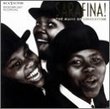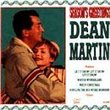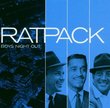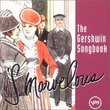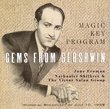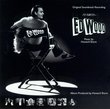| All Artists: Sergey Rachmaninov, Eugene Ormandy, Philadelphia Orchestra Title: Rachmaninov: Symphony No.2 Members Wishing: 0 Total Copies: 0 Label: RCA Release Date: 9/29/1989 Genre: Classical Styles: Historical Periods, Modern, 20th, & 21st Century, Symphonies Number of Discs: 1 SwapaCD Credits: 1 UPC: 090266013227 |
Search - Sergey Rachmaninov, Eugene Ormandy, Philadelphia Orchestra :: Rachmaninov: Symphony No.2
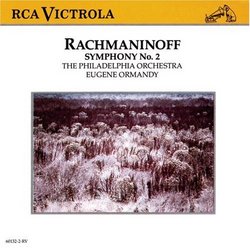 | Sergey Rachmaninov, Eugene Ormandy, Philadelphia Orchestra Rachmaninov: Symphony No.2 Genre: Classical
|
Larger Image |
CD DetailsSimilar CDs
Similarly Requested CDs
|
CD ReviewsPower Rendition Interplanetary Funksmanship | Vanilla Suburbs, USA | 10/27/2000 (5 out of 5 stars) "The 1973 Ormandy version of the Rachmaninoff Second is my personal favorite, even more than the Previn, which itself is very passionate and energetic. One of the false charges critics level against Ormandy was that his famed "Philadelphia Sound" was a uniformly applied formula of warm, lush string tonality. This simplistic contention ignores the peerless contributions of the brass, winds and percussion. But, most importantly, it ignores Eugene Ormandy's complete and subtle understanding of the music he conducted. Like Erich Leinsdorf, Ormandy could memorize a score in a few hours. Like Toscanini, Ormandy comprehended the score on an intuitive, emotional, level.This recording of the Rachmaninoff Second Symphony exemplifies this philosophy of conducting. Just as Sir John Barbirolli had a consumate, authoritative and implicit command of the music of Elgar and Sibelius, so did Eugene Ormandy possess the same qualities when it came to Rachmaninoff's. Whereas a conductor such as Stokowski or Previn (whose recording belongs in the Stokowski camp) would have command of the obvious, what gives the Ormandy recording its sense as an honest and thoroughly heartfelt performance is Ormandy's command of the intangible. What drives this performance are the nuances between and beneath the notes. A cursory listening could lead one to dismiss this performance as "formulaic," especially given the more "animated" performances out there. But with an understanding of Rachmaninoff's music, of his friendship with, and tutelage of, Ormandy, and of the ends to which Ormandy suboridinated the orchestra -- One realizes the "Philadelphia Sound" was hardly an end in itself.The first movement opens in a state of dark melancholy. The strings, especially the basses, are sumptuous and full-toned. The development of the first theme is gradual; Hints of what is to come are given, but the Philadelphia holds something back. The Rachmaninovian device of building up to the climax is very aptly employed here. The one thing I most enjoy about the performance of this movement - and the symphony as a whole - is that the when solo instrumentalists play in the foreground, they do not overshadow the playing of other sections and other soloists. This is key, since there is so much going on in this movement. It is very Russian, very Romantic: Weaving this tapestry of sound, all the threads remain integral, yet brilliantly visible. The introduction to the second theme by the violas is very delicate, punctuated acutely by the lower strings (cellos and basses). It is a very solid, yet gentle, rendering, especially as the winds wander in and out of the the orchestration. The bittersweet theme introduced by the solo clarinetist leads to the most sensual exposition of this movement I've heard. The ending of the movement is rousing, and jolts the listener with the unexpected: Instead of finishing on a single note played ff on the double-bass, Ormandy substitutes the same note played staccato on the timpani!Of all the movements, the second, Allegro molto, is the most thoroughly Russian of all. Beginning as a festive winter's sleigh ride, this panoply of jubilant sound brings to mind Rimsky-Korsakov moreso than Tchaikovsky. There is a concerted and purposeful buildup of tension to an explosive main theme, which is reintroduced in the symphony's finale. As lighthearted, however, as this movement is, the feelings of ecstasy are offset by the ever-present suggestion of mortality. What most impresses me is the sense of contrasts Ormandy and the Philadelphians present: The most striking aspect of this movement are the aggressiveness of the basses; the false expectation produced by them is spirited away in a deftly-executed and understated ending in mezzo-piano. It is a case of the fall of sledge-hammer as the prelude to the proverbial feather.The third movement, Adagio, is the most memorable of this symphony. It begins as a simple liebeslied, through a lucid and evocative solo on clarinet. The emotional theme of the movement is unmistakeable to anyone who has ever loved, and lost, a paean to unrequited love. Yet, the movement as communicated by Ormandy and the Philadelphians tells not of morose defeat, but reminiscing of the joy of love, before it was lost. With the most unadorned simplicity, the main theme is imparted by gentle turns-of-phrasing on a four note figure for oboe. Strings and brass turn over the theme, seemingly returning the passion to the present time, if only fleetingly. The restatement of the second theme, a six-note figure handed over by the solo French horn in turn to the viola, oboe, flute and clarinet suggest the passage of time since, of seasons changed and events beginning to fade from memory. The adagio ends with the flutes and clarinet. What was once a flame becomes a flicker, slowly dying out. This is the most natural and unforced playing I've ever heard of this movement. The finale (Allegro vivace), on the other hand, is an impassioned hymn of deliverance. With brass and percussion at the forefront, much of the opening theme hearkens back to the first two movements. However, the tension and conflict introduced in those movements has been resolved. The introduction of the second theme, primarily by strings - and echoed by the flutes and trumpets - gives reassurance that while love may not have triumph, that life nonetheless does. After a quite dolce interlude - a refrain from the adagio - the triumphal denouement kicks in. A celebration affirming life itself, the finale recalls the suspenseful and powerful end of the Third Concerto. Buy this disc!" One of Ormandy's Crowning Achievements. Shota Hanai | Torrance, CA | 11/17/2004 (5 out of 5 stars) "Eugene Ormandy remains one of my favorite maestros of all time, but his reputation and overall impression seems to pale from those of Karajan and Bernstein. This may be because he didn't live to record for Deustche Grammophone, probably the most high-profile and trendy label, and, more important, some performance seems much less an intruiging than others. Examples of not so impressive recordings including Shostakovich's Symphony No. 5, R. Strauss' Zarathustra (Sony), Saint-Saens' Organ Symphony (Sony). Others are good but pale to other conductors; Gershwin's American in Paris (Sony) to Bernstein, Beethoven symphonies (Sony or RCA) to Karajan. But I do know, and heaven knows, when he's good, he's REALLY REALLY GOOD. Tchaikovsky's Marche Slave (Sony), Tchaikovky's Violin Concerto (both Sony with Oistrach and EMI with Pearlman) is another; so is this album. Whether you want to be exposed by the classic "Philadelphia Sound", or listen to the America's most brilliant string section, or just to buy a mid-price CD for your collection, this is worth a fortune. Except for the dated, somewhat old cinema-like sound, a bit poor for a recent 1975 recording, the musical quality is at its highest. The famous third movement will make you want to fall in a very passionate, affectionate love. This is absoutuely one of Ormandy's crowning achievements." A beautiful, lasting and underrated performance Larkenfield | 03/02/2007 (5 out of 5 stars) "Ormandy's performance of Rachmaninov's Symphony No. 2 is one that I've repeatedly enjoyed for over 30 years, and I'm glad to be able to finally hear it in its unedited version, which Rachmaninov himself preferred. I love its warmth and vibrancy... and it is not without rhythmic vigor, urgency or excitement.
What I like about Ormandy, as compared to other self-preoccupied and indulgent conductors such as LB and others, is that his ego never comes between the composer and the performance. I find that particularly refreshing when the music comes through without the conductor standing in the way and trying to make things happen rather than letting the music generate from within itself as Ormandy does. Another highly regarded Ormandy performance is the Brahms Violin Concerto with Isaac Stern. Ormandy was known for being an effective and gracious accompanist, and his talent for this very thing is amply displayed. So while some of his performances *may* seem to lack distinction, it's certainly not the case with Rachmaninov, who happened to hold Ormandy in high regard both as a colleague and personal friend. I write this because I've found Ormandy to give consistently fine performances rather than displays of temperament, and I consider him one of the most musical of all conductors." |

 Track Listings (4) - Disc #1
Track Listings (4) - Disc #1
